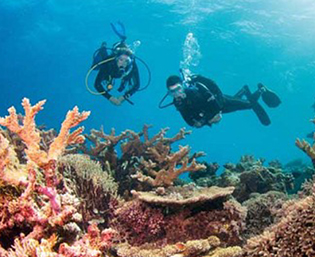Demystifying Health Effects of Global Warming
Nature’s Bounty at Risk!
Scientists are shedding light on how global warming may be adversely affecting biodiversity, triggering the spread of diseases, and threatening the supply of medically useful natural products. Jonathan Sleeman, director of the National Wildlife Health Center at the United States Geological Survey (USGS), and David Newman, former chief of the National Cancer Institute’s Natural Products Branch, talked about the threats at the April 12, 2016, Demystifying Medicine lecture.
Sleeman explained that climate change—with rising global temperatures, rising sea levels, and changes in precipitation patterns—is already having significant impacts on animal and human diseases and on the incidence and geographic distribution of pathogens. For example, the bluetongue virus—an insect-borne viral disease of cattle, sheep, goats, and yaks as well as of wild deer, elk, and other ruminants—is spreading northward in Europe and the United States. Warmer temperatures allow the insect—a midge—to survive at higher latitudes and altitudes and increase its ability to carry and transmit the virus. The economic costs of such a hard-to-treat disease include reproductive losses, damaged wool, and decreased milk production.

CREDIT: U.S. GEOLOGICAL SURVEY
Sleeman also talked about efforts to understand how avian influenza virus strains evolve and how scientists are trying to develop methods to prevent outbreaks. Wild waterfowl serve as natural reservoirs for the low-pathogenic flu virus, which can jump to domestic poultry and then to people. In addition, he discussed the human-health and agricultural implications of white-nose syndrome, which has killed millions of insect-eating bats in North America since the winter of 2007–2008.
To monitor and control public-health threats, Sleeman explained, a “One Health” approach is being promoted. The concept is ancient, but the name is recent. One Health recognizes how the health of humans is connected to the health of animals and the environment.
David Newman, an international expert in the development of therapeutics based on natural products, discussed how changes in the environment worldwide are affecting plants and other sources of medically useful natural products, the increasingly devastating effects and challenges for saving, creating repositories, and detecting unexpected mutations affecting natural product synthesis in biologic specimens.

CREDIT: NCI
NIH researchers collect natural products that may have therapeutic value from coral reefs and other areas of the ocean. But warmer ocean temperatures triggered by the El Niño weather pattern, which added to the already warmer waters caused by climate change, threatens some of the marine species.
He described how human activities and global environmental change have affected the rich biodiversity of the Antarctic and southern oceans. Coral bleaching, for example, was triggered by a temperature spike due to the El Niño weather pattern, which added to the already warmer waters caused by climate change. Warmer temperatures can kill the tiny marine algae required to maintain the health of coral and give it color.
Newman also talked about how genome mining—targeted discovery of new natural products from microbes obtained from extreme environments—has led to the identification of a gene cluster directing the biosynthesis of a lasso peptide that could be used as a therapeutic.
To view the videocast of the April 12 Demystifying Medicine lecture “Global Warming: Effect on Vector Distribution, Disease, and Natural Product Research” by Jonathan Sleeman (U.S. Geological Survey) and David Newman (NCI), go to http://videocast.nih.gov/launch.asp?19618.
This page was last updated on Wednesday, April 13, 2022
